Ahmed Awadallah
Explorer: Scaling Exploration-driven Web Trajectory Synthesis for Multimodal Web Agents
Feb 19, 2025Abstract:Recent success in large multimodal models (LMMs) has sparked promising applications of agents capable of autonomously completing complex web tasks. While open-source LMM agents have made significant advances in offline evaluation benchmarks, their performance still falls substantially short of human-level capabilities in more realistic online settings. A key bottleneck is the lack of diverse and large-scale trajectory-level datasets across various domains, which are expensive to collect. In this paper, we address this challenge by developing a scalable recipe to synthesize the largest and most diverse trajectory-level dataset to date, containing over 94K successful multimodal web trajectories, spanning 49K unique URLs, 720K screenshots, and 33M web elements. In particular, we leverage extensive web exploration and refinement to obtain diverse task intents. The average cost is 28 cents per successful trajectory, making it affordable to a wide range of users in the community. Leveraging this dataset, we train Explorer, a multimodal web agent, and demonstrate strong performance on both offline and online web agent benchmarks such as Mind2Web-Live, Multimodal-Mind2Web, and MiniWob++. Additionally, our experiments highlight data scaling as a key driver for improving web agent capabilities. We hope this study makes state-of-the-art LMM-based agent research at a larger scale more accessible.
Magentic-One: A Generalist Multi-Agent System for Solving Complex Tasks
Nov 07, 2024Abstract:Modern AI agents, driven by advances in large foundation models, promise to enhance our productivity and transform our lives by augmenting our knowledge and capabilities. To achieve this vision, AI agents must effectively plan, perform multi-step reasoning and actions, respond to novel observations, and recover from errors, to successfully complete complex tasks across a wide range of scenarios. In this work, we introduce Magentic-One, a high-performing open-source agentic system for solving such tasks. Magentic-One uses a multi-agent architecture where a lead agent, the Orchestrator, plans, tracks progress, and re-plans to recover from errors. Throughout task execution, the Orchestrator directs other specialized agents to perform tasks as needed, such as operating a web browser, navigating local files, or writing and executing Python code. We show that Magentic-One achieves statistically competitive performance to the state-of-the-art on three diverse and challenging agentic benchmarks: GAIA, AssistantBench, and WebArena. Magentic-One achieves these results without modification to core agent capabilities or to how they collaborate, demonstrating progress towards generalist agentic systems. Moreover, Magentic-One's modular design allows agents to be added or removed from the team without additional prompt tuning or training, easing development and making it extensible to future scenarios. We provide an open-source implementation of Magentic-One, and we include AutoGenBench, a standalone tool for agentic evaluation. AutoGenBench provides built-in controls for repetition and isolation to run agentic benchmarks in a rigorous and contained manner -- which is important when agents' actions have side-effects. Magentic-One, AutoGenBench and detailed empirical performance evaluations of Magentic-One, including ablations and error analysis are available at https://aka.ms/magentic-one
OmniParser for Pure Vision Based GUI Agent
Aug 01, 2024



Abstract:The recent success of large vision language models shows great potential in driving the agent system operating on user interfaces. However, we argue that the power multimodal models like GPT-4V as a general agent on multiple operating systems across different applications is largely underestimated due to the lack of a robust screen parsing technique capable of: 1) reliably identifying interactable icons within the user interface, and 2) understanding the semantics of various elements in a screenshot and accurately associate the intended action with the corresponding region on the screen. To fill these gaps, we introduce \textsc{OmniParser}, a comprehensive method for parsing user interface screenshots into structured elements, which significantly enhances the ability of GPT-4V to generate actions that can be accurately grounded in the corresponding regions of the interface. We first curated an interactable icon detection dataset using popular webpages and an icon description dataset. These datasets were utilized to fine-tune specialized models: a detection model to parse interactable regions on the screen and a caption model to extract the functional semantics of the detected elements. \textsc{OmniParser} significantly improves GPT-4V's performance on ScreenSpot benchmark. And on Mind2Web and AITW benchmark, \textsc{OmniParser} with screenshot only input outperforms the GPT-4V baselines requiring additional information outside of screenshot.
sPhinX: Sample Efficient Multilingual Instruction Fine-Tuning Through N-shot Guided Prompting
Jul 16, 2024Abstract:Despite the remarkable success of LLMs in English, there is a significant gap in performance in non-English languages. In order to address this, we introduce a novel recipe for creating a multilingual synthetic instruction tuning dataset, sPhinX, which is created by selectively translating instruction response pairs from English into 50 languages. We test the effectiveness of sPhinX by using it to fine-tune two state-of-the-art models, Phi-3-small and Mistral-7B and then evaluating them across a comprehensive suite of multilingual benchmarks that test reasoning, question answering, and reading comprehension. Our results show that Phi-3-small and Mistral-7B fine-tuned with sPhinX perform better on an average by 4.2%pt and 5%pt respectively as compared to the baselines. We also devise a strategy to incorporate N-shot examples in each fine-tuning sample which further boosts the performance of these models by 3%pt and 10%pt respectively. Additionally, sPhinX also outperforms other multilingual instruction tuning datasets on the same benchmarks along with being sample efficient and diverse, thereby reducing dataset creation costs. Additionally, instruction tuning with sPhinX does not lead to regression on most standard LLM benchmarks.
AgentInstruct: Toward Generative Teaching with Agentic Flows
Jul 03, 2024



Abstract:Synthetic data is becoming increasingly important for accelerating the development of language models, both large and small. Despite several successful use cases, researchers also raised concerns around model collapse and drawbacks of imitating other models. This discrepancy can be attributed to the fact that synthetic data varies in quality and diversity. Effective use of synthetic data usually requires significant human effort in curating the data. We focus on using synthetic data for post-training, specifically creating data by powerful models to teach a new skill or behavior to another model, we refer to this setting as Generative Teaching. We introduce AgentInstruct, an extensible agentic framework for automatically creating large amounts of diverse and high-quality synthetic data. AgentInstruct can create both the prompts and responses, using only raw data sources like text documents and code files as seeds. We demonstrate the utility of AgentInstruct by creating a post training dataset of 25M pairs to teach language models different skills, such as text editing, creative writing, tool usage, coding, reading comprehension, etc. The dataset can be used for instruction tuning of any base model. We post-train Mistral-7b with the data. When comparing the resulting model Orca-3 to Mistral-7b-Instruct (which uses the same base model), we observe significant improvements across many benchmarks. For example, 40% improvement on AGIEval, 19% improvement on MMLU, 54% improvement on GSM8K, 38% improvement on BBH and 45% improvement on AlpacaEval. Additionally, it consistently outperforms other models such as LLAMA-8B-instruct and GPT-3.5-turbo.
Exploratory Preference Optimization: Harnessing Implicit Q*-Approximation for Sample-Efficient RLHF
May 31, 2024

Abstract:Reinforcement learning from human feedback (RLHF) has emerged as a central tool for language model alignment. We consider online exploration in RLHF, which exploits interactive access to human or AI feedback by deliberately encouraging the model to produce diverse, maximally informative responses. By allowing RLHF to confidently stray from the pre-trained model, online exploration offers the possibility of novel, potentially super-human capabilities, but its full potential as a paradigm for language model training has yet to be realized, owing to computational and statistical bottlenecks in directly adapting existing reinforcement learning techniques. We propose a new algorithm for online exploration in RLHF, Exploratory Preference Optimization (XPO), which is simple and practical -- a one-line change to (online) Direct Preference Optimization (DPO; Rafailov et al., 2023) -- yet enjoys the strongest known provable guarantees and promising empirical performance. XPO augments the DPO objective with a novel and principled exploration bonus, empowering the algorithm to explore outside the support of the initial model and human feedback data. In theory, we show that XPO is provably sample-efficient and converges to a near-optimal language model policy under natural exploration conditions, irrespective of whether the initial model has good coverage. Our analysis, which builds on the observation that DPO implicitly performs a form of $Q^{\star}$-approximation (or, Bellman error minimization), combines previously disparate techniques from language modeling and theoretical reinforcement learning in a serendipitous fashion through the perspective of KL-regularized Markov decision processes. Empirically, we find that XPO is more sample-efficient than non-exploratory DPO variants in a preliminary evaluation.
Assessing and Verifying Task Utility in LLM-Powered Applications
May 03, 2024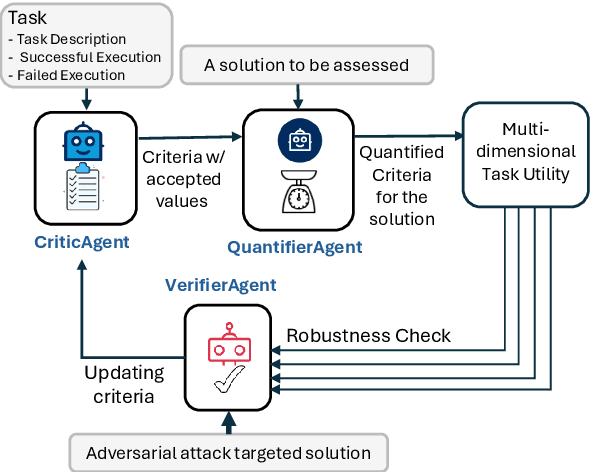

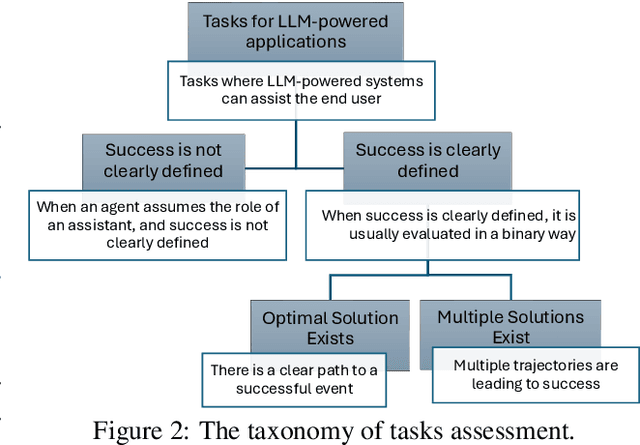
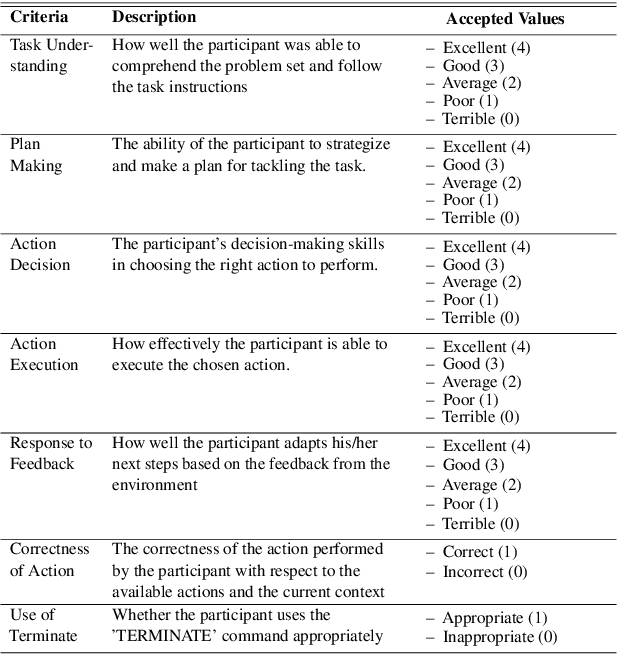
Abstract:The rapid development of Large Language Models (LLMs) has led to a surge in applications that facilitate collaboration among multiple agents, assisting humans in their daily tasks. However, a significant gap remains in assessing to what extent LLM-powered applications genuinely enhance user experience and task execution efficiency. This highlights the need to verify utility of LLM-powered applications, particularly by ensuring alignment between the application's functionality and end-user needs. We introduce AgentEval, a novel framework designed to simplify the utility verification process by automatically proposing a set of criteria tailored to the unique purpose of any given application. This allows for a comprehensive assessment, quantifying the utility of an application against the suggested criteria. We present a comprehensive analysis of the effectiveness and robustness of AgentEval for two open source datasets including Math Problem solving and ALFWorld House-hold related tasks. For reproducibility purposes, we make the data, code and all the logs publicly available at https://bit.ly/3w3yKcS .
Phi-3 Technical Report: A Highly Capable Language Model Locally on Your Phone
Apr 23, 2024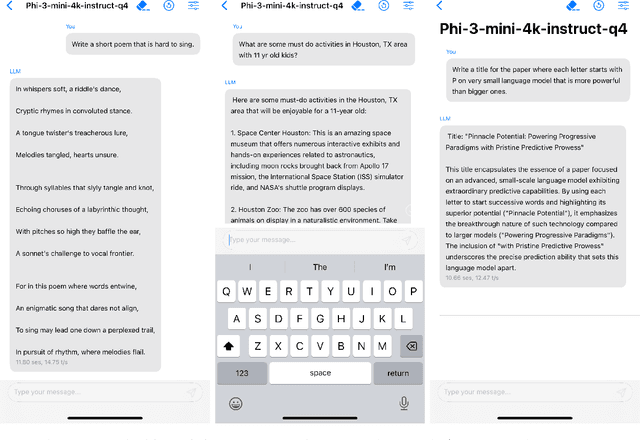

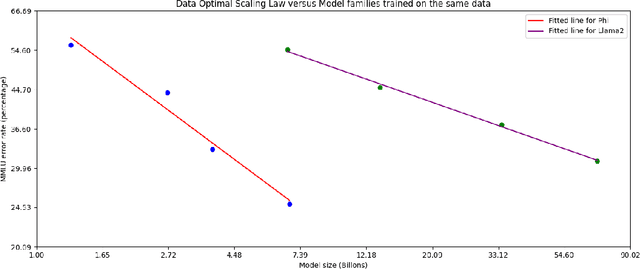
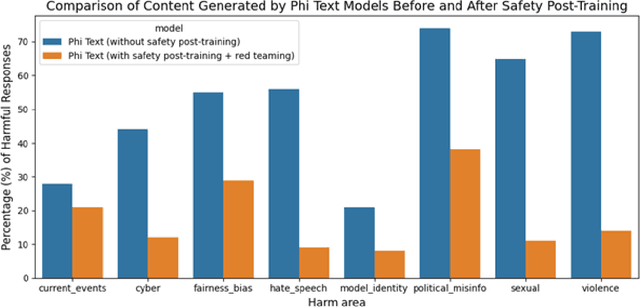
Abstract:We introduce phi-3-mini, a 3.8 billion parameter language model trained on 3.3 trillion tokens, whose overall performance, as measured by both academic benchmarks and internal testing, rivals that of models such as Mixtral 8x7B and GPT-3.5 (e.g., phi-3-mini achieves 69% on MMLU and 8.38 on MT-bench), despite being small enough to be deployed on a phone. The innovation lies entirely in our dataset for training, a scaled-up version of the one used for phi-2, composed of heavily filtered web data and synthetic data. The model is also further aligned for robustness, safety, and chat format. We also provide some initial parameter-scaling results with a 7B and 14B models trained for 4.8T tokens, called phi-3-small and phi-3-medium, both significantly more capable than phi-3-mini (e.g., respectively 75% and 78% on MMLU, and 8.7 and 8.9 on MT-bench).
Direct Nash Optimization: Teaching Language Models to Self-Improve with General Preferences
Apr 04, 2024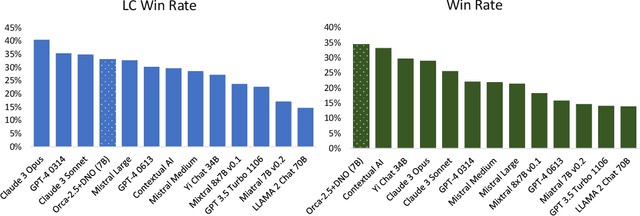
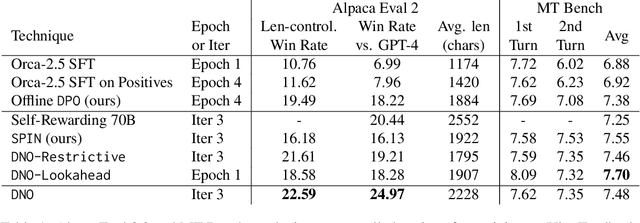
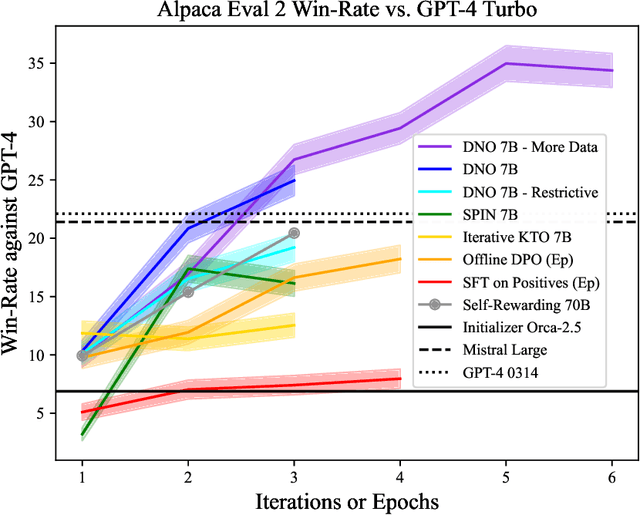

Abstract:This paper studies post-training large language models (LLMs) using preference feedback from a powerful oracle to help a model iteratively improve over itself. The typical approach for post-training LLMs involves Reinforcement Learning from Human Feedback (RLHF), which traditionally separates reward learning and subsequent policy optimization. However, such a reward maximization approach is limited by the nature of "point-wise" rewards (such as Bradley-Terry model), which fails to express complex intransitive or cyclic preference relations. While advances on RLHF show reward learning and policy optimization can be merged into a single contrastive objective for stability, they yet still remain tethered to the reward maximization framework. Recently, a new wave of research sidesteps the reward maximization presumptions in favor of directly optimizing over "pair-wise" or general preferences. In this paper, we introduce Direct Nash Optimization (DNO), a provable and scalable algorithm that marries the simplicity and stability of contrastive learning with theoretical generality from optimizing general preferences. Because DNO is a batched on-policy algorithm using a regression-based objective, its implementation is straightforward and efficient. Moreover, DNO enjoys monotonic improvement across iterations that help it improve even over a strong teacher (such as GPT-4). In our experiments, a resulting 7B parameter Orca-2.5 model aligned by DNO achieves the state-of-the-art win-rate against GPT-4-Turbo of 33% on AlpacaEval 2.0 (even after controlling for response length), an absolute gain of 26% (7% to 33%) over the initializing model. It outperforms models with far more parameters, including Mistral Large, Self-Rewarding LM (70B parameters), and older versions of GPT-4.
Researchy Questions: A Dataset of Multi-Perspective, Decompositional Questions for LLM Web Agents
Feb 27, 2024



Abstract:Existing question answering (QA) datasets are no longer challenging to most powerful Large Language Models (LLMs). Traditional QA benchmarks like TriviaQA, NaturalQuestions, ELI5 and HotpotQA mainly study ``known unknowns'' with clear indications of both what information is missing, and how to find it to answer the question. Hence, good performance on these benchmarks provides a false sense of security. A yet unmet need of the NLP community is a bank of non-factoid, multi-perspective questions involving a great deal of unclear information needs, i.e. ``unknown uknowns''. We claim we can find such questions in search engine logs, which is surprising because most question-intent queries are indeed factoid. We present Researchy Questions, a dataset of search engine queries tediously filtered to be non-factoid, ``decompositional'' and multi-perspective. We show that users spend a lot of ``effort'' on these questions in terms of signals like clicks and session length, and that they are also challenging for GPT-4. We also show that ``slow thinking'' answering techniques, like decomposition into sub-questions shows benefit over answering directly. We release $\sim$ 100k Researchy Questions, along with the Clueweb22 URLs that were clicked.
 Add to Chrome
Add to Chrome Add to Firefox
Add to Firefox Add to Edge
Add to Edge